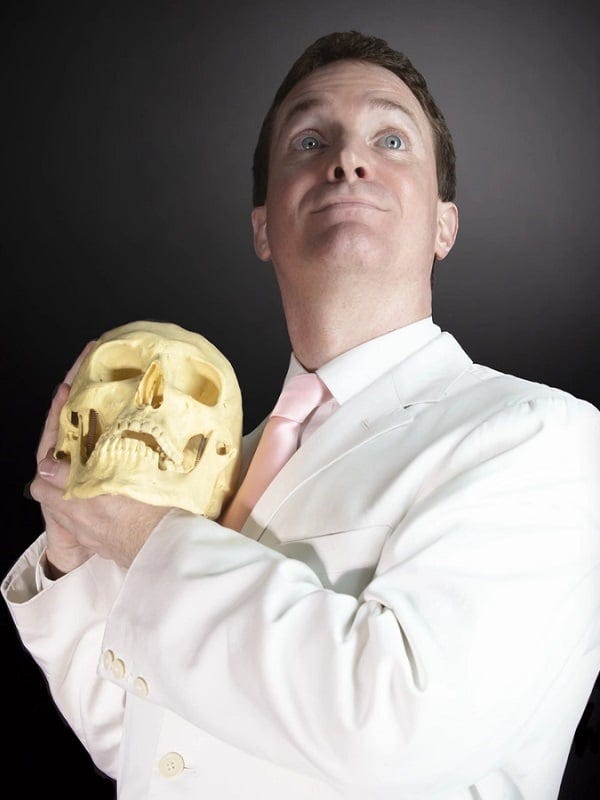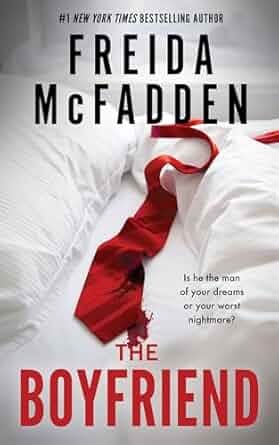Donna Tartt, author of The Secret History, is publicity-shy and eschews social media. During rare public appearances, she favors dark, masculine attire to complement her severe bob.
Tartt’s mystique is part of her brand, and because she’s so inaccessible, her readers are endlessly curious about her. Unlike Tartt, few authors can get away with keeping readers at an arm’s length, and the way we show up for them is part of our brand.
Grady Hendrix, who broke out with The Southern Book Club's Guide to Slaying Vampires, pairs horror with humor.
Author photos show him posing dramatically with a skull, his Instagram demonstrates light-hearted spooky fun, and even his list of appearances leans into his brand. When describing an upcoming event, he writes: “The Westerville Public Library is bringing me to Columbus to destroy the morals and values of this small, upstanding community. Poor souls, they’ll never know what hit them, but they will regret it forever.”
Last week, I discussed the discovery process of author branding, which involves introspection about your worldview. This week, I’ll cover how to authentically share that worldview with others.
It begins with the novel
In an interview with Oprah, Paulo Coelho , author of The Alchemist talked about his writing journey, saying, “ I had a dream, but had not yet dared to fulfill it. But then you start paying attention, and there is a symbol here, and one there, and if you put the puzzle together, you will understand.”
It’s the same with an authentic author brand. You often have to feel your way into it, and you’ll likely make mistakes, but it all begins with sitting down and writing the novel.
Most writers begin with genre, and they might say to themselves, “Well, I enjoy domestic thrillers, so I’ll write one.” Very often, they’ll produce work similar to what they’ve read, and their efforts are more about trying to fit in than to stand out. That’s why there are so many derivative novels.
But instead of starting with genre, try making a list of the movies and books you enjoy and identify the themes they have in common.
Blake Snyder, author of Save the Cat, came up with ten story types that zero in on the thematic issues embedded in genres. I remembering have a revelation when I first read about the institutional genre, which is “how a hero who is entrenched inside a certain group, institution, or establishment fits into that system—or doesn’t. The hero must decide if being part of the group is worth it, and must choose to join, leave, or destroy it.”
I immediately connected with the aims of the institutional story, and it informs the majority of my work.
Institutional stories might not speak to you, but there’s likely a Blake Snyder story that does. Blake isn’t the only person who identified thematic-driven stories; Kurt Vonnegut also identified several.
Daring to Be Different
Ashley Posten used to write young adult novels and decided to enter the crowded adult romance market. What set her apart was her love for ghost stories, which she combined with romance. Now she’s known for having fresh, magical realism elements in her romances like a woman who falls in love with a character in a book or a man from a different time period.
As authors, we’re often told to be like everyone else, i.e., in terms of tropes, covers, comps, and blurbs, but the authors who risk being different, like Poston, are the ones who intrigue readers most.
According to The 22 Immutable Laws of Branding by Al Ries and Laura Ries, “A successful brand is based on singularity, creating in the mind of the prospect the perception that there is no product on the market quite like your product.”
In a world that values comps and read-alikes, it’s important to defend your unique take on storytelling. What perspective do you bring to your fiction that no one else can duplicate? Are you willing to take the risk to step away from the herd?
Sharing Your Worldview with Others
Anne Lamott’s first book, Hard Laughter, was a funny novel about her father’s death from brain cancer, and it established her as a writer who writes about difficult topics with warmth, irreverent humor, and unflinching honesty. As her bio, says, “Anne Lamott writes and speaks about subjects that begin with capital letters: Alcoholism, Motherhood, Jesus. But armed with self-effacing humor – she is laugh-out-loud funny – and ruthless honesty, Lamott converts her subjects into enchantment.”
Once you identify your brand, you can convey it via your website, social media posts, essays, and interviews. For instance, when Lamott comments on politics on X, it’s usually funny and irreverent like this quote from Preet Bharara: Can girls have 30 dolls if they’re a gift from Qatar?
She also writes essays that demonstrate her special brand of authenticity. This one (gift link) is pure Anne Lamott, humorously relating her aging to the difficult times our country is experiencing but ending on a note of hope.
Similarly, psychological thriller novelist Freida McFadden established a brand early on with her titles: The Inmate, The Teacher, The Tenant, and The Boyfriend are just a few of her titles that signify her brand. The background of her website is black.
The novels are all written in first-person, present tense, and her all covers have a a stark look. Her bio says, “Freida lives with her family and cat in a centuries-old three-story home overlooking the ocean, with staircases that creak and moan with each step, and nobody could hear you if you scream. Unless you scream really loudly, maybe
What emotional message are you sending to readers with your website, social media shares, essays, author photo, and author bio? Does everything align with your brand? Are you consistent?
P.S. After over twenty yeas of being an author, I’m in the process of changing my branding, and when I finish I will share some of that work with you.
Comments, questions? Love to hear from you.
News You Can Use
Covers are an important part of the author brand. What are the trends?
I used to write time-consuming book round-ups, so it’s disheartening to see someone take a shortcut with AI . Obviously, the writer had no knowledge of books because a new Delia Owens novel would be huge news and should have stuck out as being wrong.
Backlash for a dystopian romance written by a writer with no internet presence.
I’m booked up with writer services until June 9, but have openings starting then.
Summer Reading Lists
From Zibby Owens and The Atlantic (Gift link).








I really loved the Anne Lamott bio example. Exceedingly helpful model and true to her writing too. Thank you for this! It's super helpful for next time I rewrite my bio (again!).
I keep getting prompts to build my social media presence, website, etc. I'd love to be a recluse like Thomas Pynchon, if only I could write like him. Thanks for a great read.